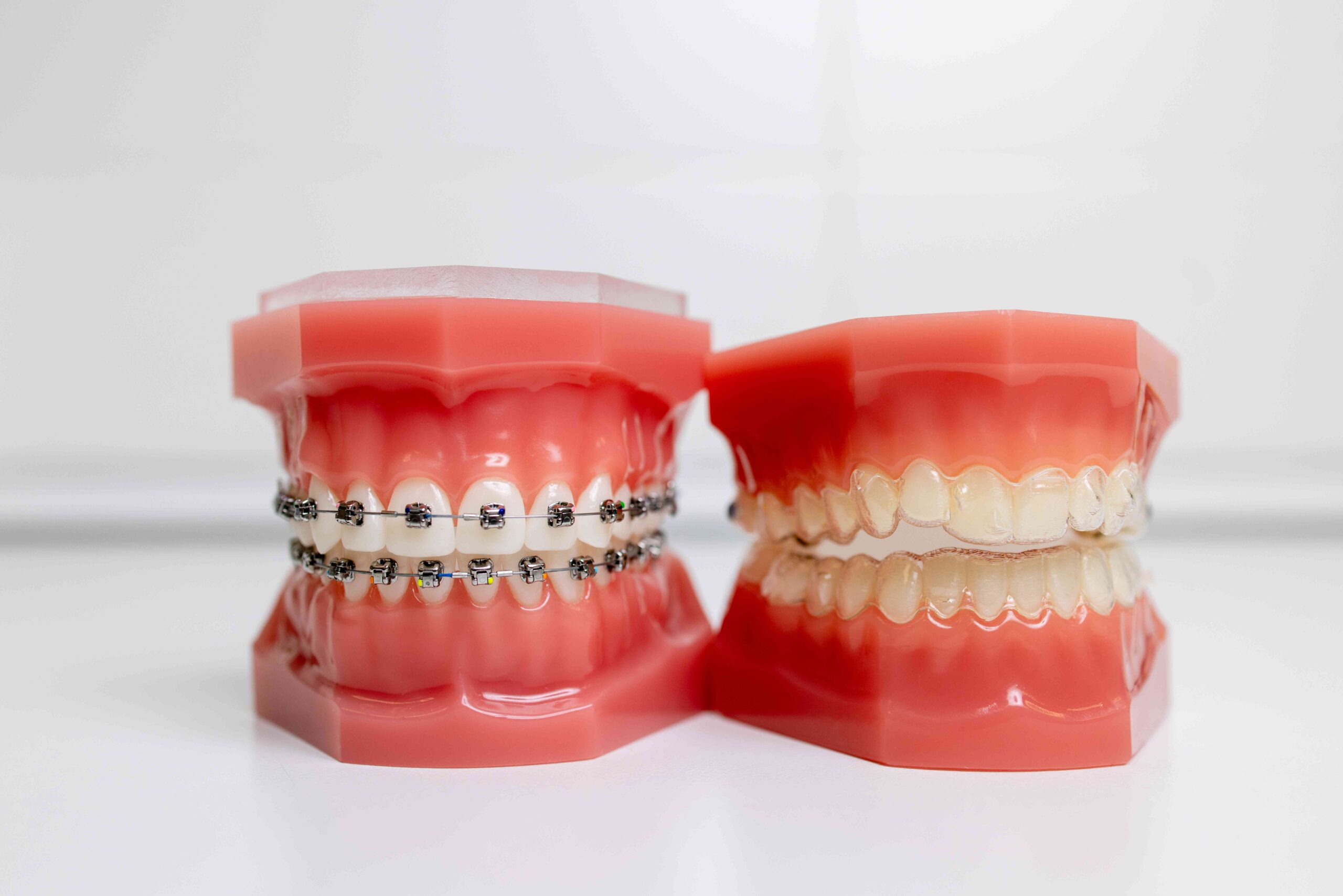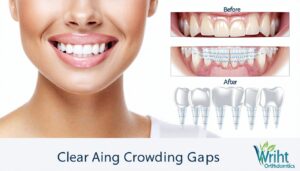Understanding Clear Aligners
When it comes to achieving a beautiful smile, there are several options available. One such option that has gained popularity in recent years is clear aligners. These are a modern, esthetic-oriented solution for straightening teeth, and they offer several advantages over traditional braces.
How Clear Aligners Work
Clear aligners are plastic replicas of teeth that apply gentle pressure to reposition your teeth slightly over time. This is achieved using a series of clear, thin, plastic-like trays that are virtually invisible when worn. The clear aligners are designed based on a digital impression of your teeth, ensuring a perfect fit. To guide the teeth into their new positions, tooth-colored attachments are often placed on the teeth. These aligners are one of the technological advancements making orthodontic treatment less conspicuous. (AAO)
Benefits of Clear Aligners
There are several benefits to using clear aligners for orthodontic treatment. First and foremost, they are almost invisible compared to traditional braces, making them less conspicuous in appearance. This allows individuals to undergo orthodontic treatment without feeling self-conscious about their appearance. (St. Anthony Park Dental Care)
In addition to their aesthetic appeal, clear aligners offer a more friendly, tolerable, comfortable, and acceptable treatment process to the patient. This is largely due to their removable nature, which allows for easy cleaning and maintenance. Plus, you can eat and drink whatever you want without having to worry about food getting stuck in your braces.
Moreover, clear aligners have been highlighted as being more efficient and effective than braces, especially in a COVID-19 world. Their removable nature allows for better oral hygiene, reducing the risk of tooth decay and gum disease during treatment.
In conclusion, clear aligners are a versatile and convenient option for those looking to achieve a beautiful smile. With their numerous benefits and advancements in technology, they are a compelling alternative to traditional braces.
Exploring Traditional Braces
As we delve into the world of orthodontic corrections, it becomes clear that the choice between clear aligners and traditional braces plays a significant role in the journey to a beautiful smile. This section will focus on traditional braces, examining their functionality and the advantages they offer.
Functionality of Traditional Braces
Traditional braces consist of metal or ceramic brackets that are adhered to the teeth, connected by a wire that applies pressure to gradually shift the teeth into proper alignment. They have been the traditional form of treatment used by orthodontists for decades and are known for their effectiveness in correcting a wide range of orthodontic problems.
One of the key elements of traditional braces is their ability to treat a wide variety of alignment issues. Unlike clear aligners, which are best suited for mild to moderate bite problems, traditional braces can effectively manage severe alignment issues.
Advantages of Traditional Braces
Despite the recent popularity of clear aligners, traditional braces still offer several advantages. First and foremost, they are highly effective. Most orthodontic problems, from simple to complex, can be successfully treated with braces.
Braces come in various models, including stainless steel, tooth-colored ceramic, and even gold-colored options. This diversity in models allows for a degree of personalization and can make the treatment process more appealing, especially for younger patients.
Another advantage of traditional braces is their durability. Unlike clear aligners, which are made of plastic and may be more prone to damage, braces are robust and can withstand the rigors of daily wear.
On the downside, traditional braces are more noticeable than clear aligners. However, for those who prioritize effectiveness and versatility over aesthetics, traditional braces remain an excellent choice.
In the showdown between clear aligners vs traditional braces, it’s essential to consider these factors along with individual needs and preferences to make an informed decision. The ultimate goal is to achieve a beautiful, healthy smile, and both clear aligners and traditional braces can play a significant role in that journey.
Clear Aligners vs Traditional Braces: Effectiveness
When considering orthodontic treatment, effectiveness is a major deciding factor. In this section, we delve into the accuracy and efficiency of clear aligners, and compare this with the precision and efficacy of traditional braces.
Accuracy and Efficiency of Clear Aligners
Clear aligners, such as the Invisalign® system, have been developed specifically for adult patients and can be used to treat complex malocclusions. However, the results achieved with Invisalign® are not as accurate as those attained with fixed appliances, such as traditional braces.
The accuracy of movement with Invisalign® ranges from 55% to 72%, depending on whether the aligner is changed weekly or biweekly. Despite this, clear aligners are considered more efficient and effective to use than braces, especially in a COVID-19 world, as it reduces the number of office visits and emergencies.
Clear aligners also offer a more friendly, tolerable, comfortable, and acceptable treatment process to the patient, being more aesthetic-oriented and less conspicuous in appearance (St. Anthony Park Dental Care).
Precision and Efficacy of Traditional Braces
Traditional braces, on the other hand, provide a higher degree of precision in correcting severe alignment issues. While clear aligners work well for mild to moderate bite problems, traditional braces are better suited for more complex cases.
Though they are more noticeable than clear aligners, the results they deliver in terms of tooth alignment and bite correction are more precise. This is due to the firm, unwavering grip traditional braces have on the teeth, allowing for more controlled and accurate tooth movements.
| Clear Aligners | Traditional Braces |
|---|---|
| 55% to 72% accuracy rate | More precise for severe alignment issues |
| Efficient and effective | Provides controlled and accurate tooth movements |
| Less conspicuous | More noticeable |
In the battle of clear aligners vs traditional braces, each has its strengths and limitations. The choice between the two would largely depend on the individual’s specific needs, preferences, and the complexity of their case. It’s important to consult with a dental professional to understand which option would work best for your smile makeover journey.
Clear Aligners vs Traditional Braces: Comparison Factors
When comparing clear aligners and traditional braces, it’s important to consider a few key factors. These include the duration and complexity of treatment, as well as cost and insurance considerations. Let’s dig deeper into these factors.
Treatment Duration and Complexity
The length of treatment with clear aligners or traditional braces depends on the individual’s orthodontic needs. According to a study cited on NCBI, the treatment duration with Invisalign®, a type of clear aligner, varies depending on the degree of crowding, ranging from 13.4 to 17.92 months. However, on average, the treatment duration for clear aligners is typically less than two years. In contrast, traditional braces usually take between one and three years for completion, as per Sap Dental Care.
In terms of complexity, clear aligners offer a more straightforward approach to treatment. Patients simply need to switch to a new tray as per their treatment plan, which reduces the need for frequent in-person adjustments. This has proven particularly efficient and effective in the current COVID-19 world, as it reduces the number of office visits and emergencies.
Cost and Insurance Considerations
The cost of clear aligners and traditional braces can vary depending on several factors, including the length and complexity of treatment, the region, and the specific orthodontist. Generally, clear aligners cost more upfront than traditional braces. However, the overall cost can be comparable when factoring in additional expenses associated with braces, such as adjustment appointments and potential repairs.
It’s also important to consider insurance coverage when comparing the costs of clear aligners and traditional braces. Some insurance plans may cover a portion of the cost of orthodontic treatment, but the amount of coverage can vary significantly. It’s recommended to check with your insurance provider to understand what costs are covered before making a decision.
When considering clear aligners vs traditional braces, it’s crucial to take into account not only the aesthetic differences and treatment results but also practical factors such as treatment duration and financial considerations. By weighing all these factors, you can make an informed decision that best suits your needs and circumstances.
Clear Aligners: Maintenance and Lifestyle
When exploring the topic of ‘clear aligners vs traditional braces’, it’s critical to consider the maintenance and lifestyle implications of each orthodontic treatment option. Herein, we will focus on clear aligners, examining the impact on oral hygiene and lifestyle.
Oral Hygiene with Clear Aligners
Clear aligners provide a distinct advantage when it comes to oral hygiene. Patients undergoing treatment with clear aligners find it easier to maintain optimal hygiene, as they can remove the trays to eat, drink, floss, and brush. This flexibility leads to better hygiene practices during orthodontic treatment, reducing the risk of dental issues such as cavities or gum disease. As per ORMCO, this ease of cleaning is a significant advantage over traditional braces, which require special care and tools for effective cleaning.
Moreover, Invisalign retainers, a popular brand of clear aligners, are made of a special plastic and custom-fitted for each patient’s mouth. This design minimizes irritation and damage to the gums and inside of the mouth – a common issue with traditional braces.
Lifestyle Impact of Clear Aligners
The impact of clear aligners on lifestyle is generally positive, offering a level of convenience and discretion that traditional braces can’t match. Invisalign aligners, for example, are virtually invisible, providing a discreet way to straighten teeth while maintaining confidence during treatment.
Furthermore, patients using Invisalign typically require fewer consultations compared to braces, as much of the orthodontist’s work is done before the aligners are worn, keeping visits to a minimum. This convenience can be a significant advantage for busy individuals.
Lastly, with clear aligners, patients don’t have to worry about dietary restrictions that come with traditional braces. People with braces must avoid hard, sticky, crunchy, and chewy foods to prevent damage to the brackets or wires. With clear aligners, these restrictions don’t exist as the aligners are removed during meals.
In summary, clear aligners provide several benefits concerning maintenance and lifestyle. They simplify oral hygiene practices, offer a discreet treatment option, minimize orthodontist visits, and don’t impose dietary restrictions. These factors make clear aligners an attractive option for many individuals seeking a beautiful smile.
Making the Choice: Aligners or Braces
Choosing between clear aligners and traditional braces involves considering several factors. These include the effectiveness of the treatment, the impact on your lifestyle, the complexity of your dental issues, and, of course, cost.
Factors Influencing the Decision
Clear aligners are favored for being esthetic-oriented, offering a more friendly, tolerable, comfortable, and acceptable treatment process. They are especially efficient and effective during a pandemic, reducing the number of office visits and emergencies.
Moreover, clear aligners are removable trays that can shift teeth to better positions in the mouth. They provide advantages over braces in terms of cleanliness, manageability, and incorporation into daily life (ORMCO).
On the other hand, traditional braces are known for their precision and efficacy, especially when dealing with more complex dental issues.
Personalized Treatment Plans
Every individual’s dental needs are unique. Therefore, the choice between clear aligners vs traditional braces should be made after a thorough consultation with an orthodontist. They can guide you based on your specific needs and desired outcomes.
Invisalign aligners, for example, offer a discreet way to straighten teeth while allowing users to maintain their confidence during treatment. These custom-made aligners gradually shift teeth into the desired position comfortably and effectively (Crown & Roots).
Treatment with clear aligners can result in decreased visits to the orthodontic office. Patients simply need to switch to a new tray as per their treatment plan, removing the need for frequent in-person adjustments.
In terms of cost, various levels of treatment are available based on a patient’s financial needs and desires. This offers flexibility in payment options and affordability for all.
Ultimately, the decision between clear aligners vs traditional braces should be based on a comprehensive evaluation of the individual’s needs, lifestyle, and budget. By understanding the pros and cons of each option, you can make an informed decision towards achieving a beautiful smile.






